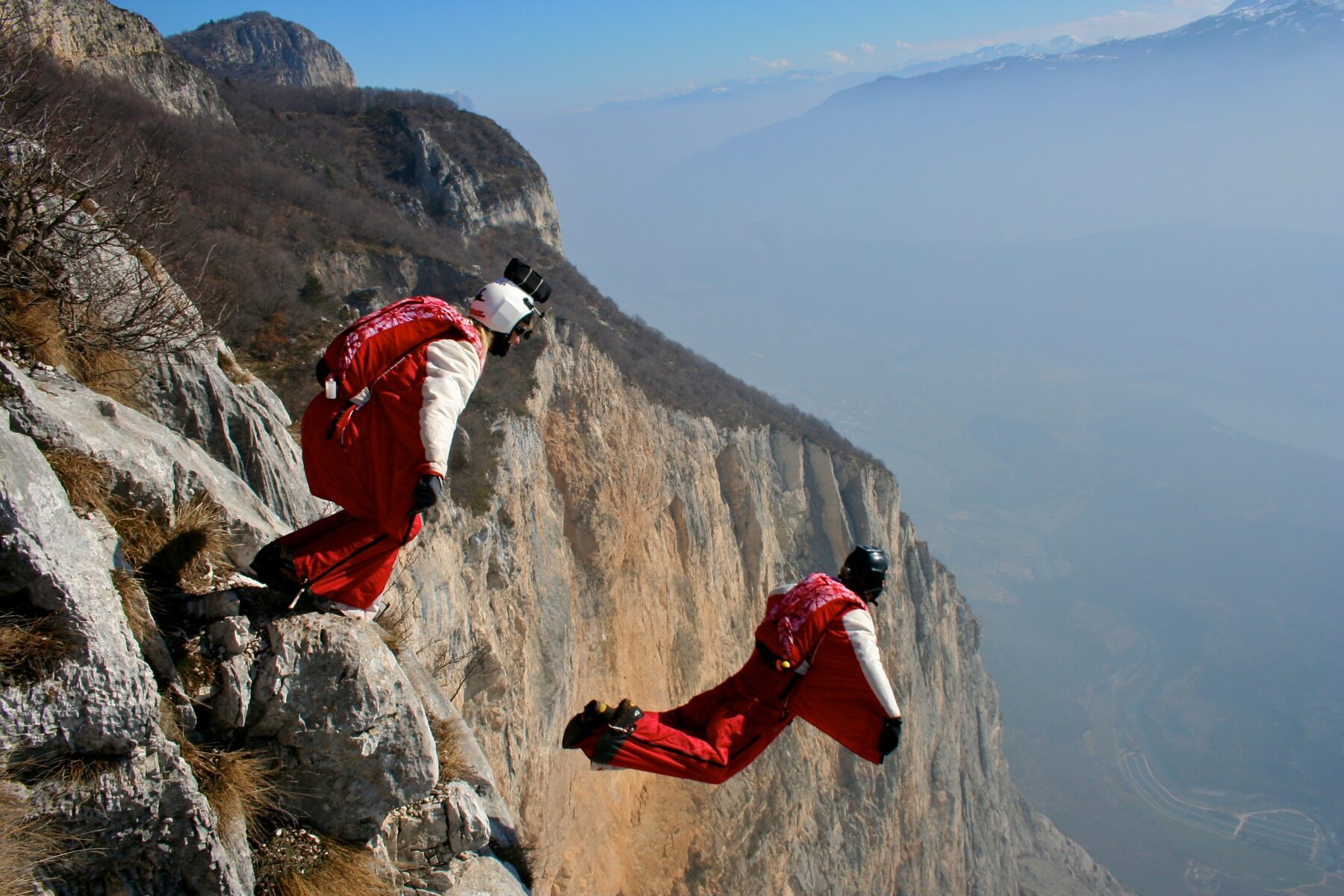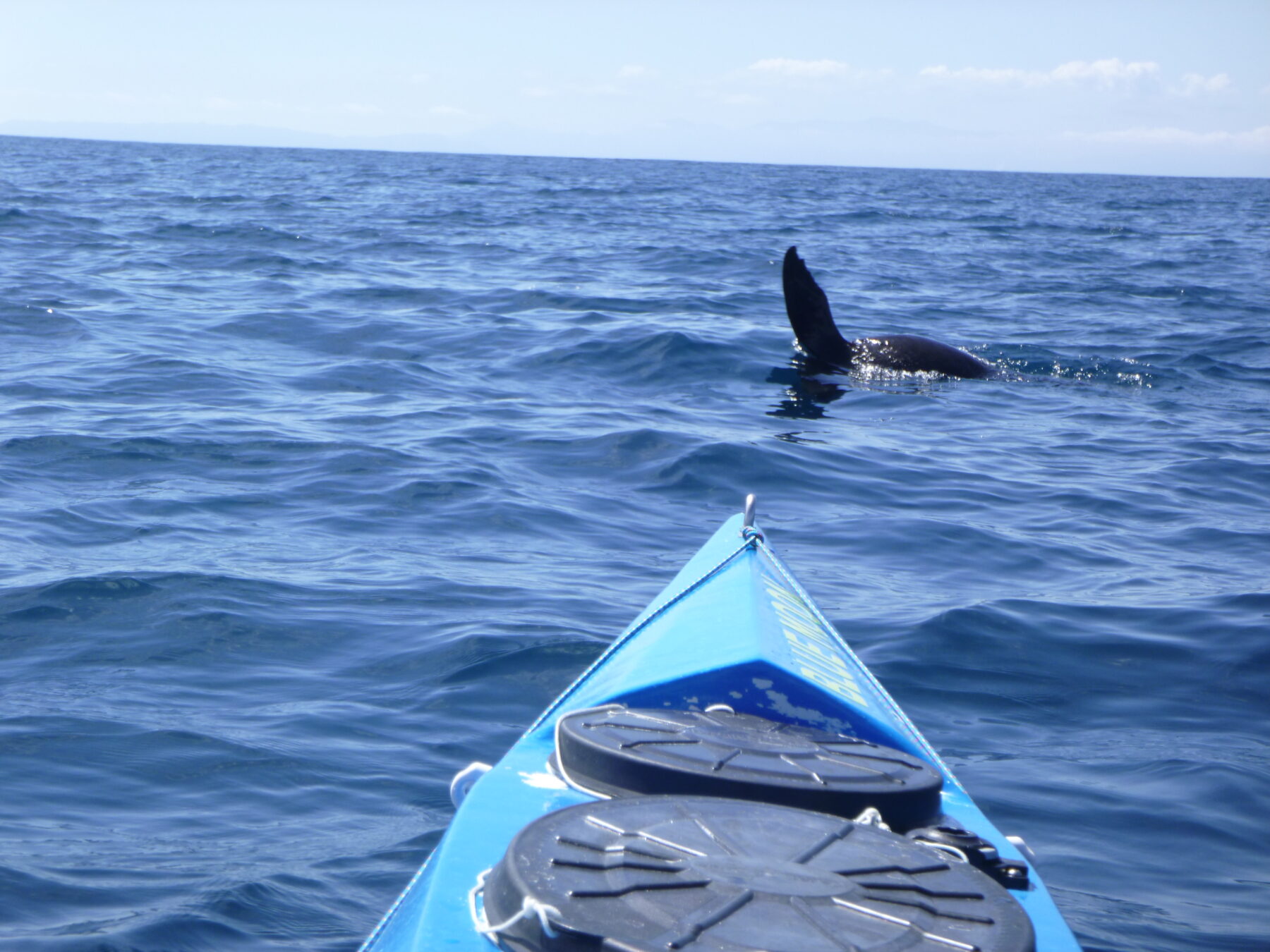Lifetime of Adventure
Sponsored by Coral Expeditions
Glenn Singleman and Heather Swan
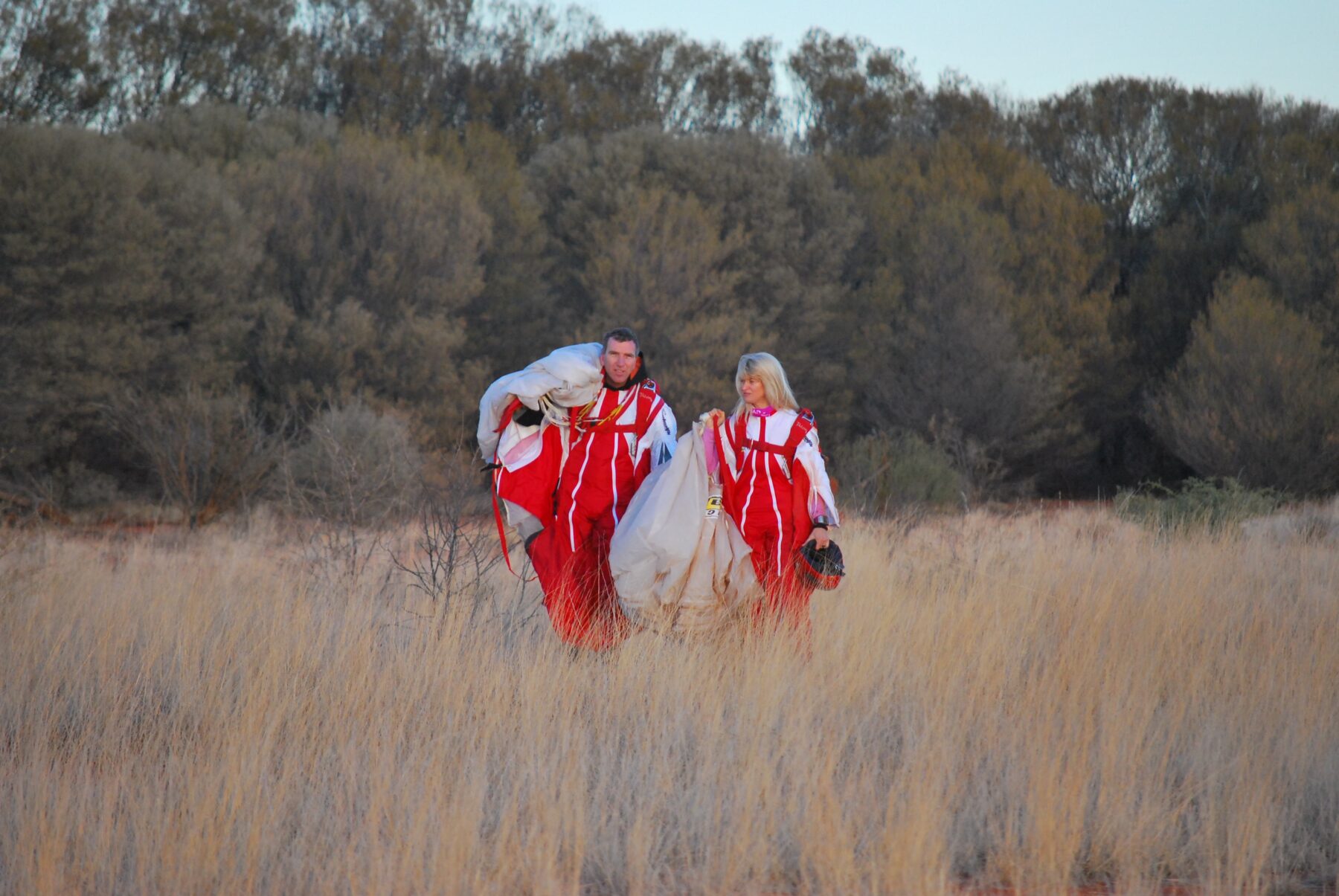
Heather Swan’s journey into extreme sport was taken one step at a time. “As you grow your ability and your sense of self-efficacy, the answer to ‘What would you do if you weren’t afraid?’ becomes, ‘I’d like to climb up the highest cliff in the world and jump off it in a wingsuit!’” she says.
Heather and her husband, Dr Glenn Singleman, are world record–holding extreme-sport athletes and two-time recipients of the Australian Geographic Spirit of Adventure medal. They’re best known for their gravity-defying stunts as wingsuit pilots. Glenn is an award-winning documentary filmmaker and physician specialising in remote, rural and expedition medicine. Heather is an inspirational speaker, farmer, photographer and author.
Together, they use their skills to champion wilderness; advocate the emotional, spiritual and physical benefits of adventuring; and inspire audiences to face their fears.

Glenn was introduced to the world of adventure by a medical colleague, who invited him on a canyoning trip in the Blue Mountains. It sparked a revelation into the ways fear was limiting his life. “I started a very deliberate exploration of how to overcome those fears and discover what’s possible for me,” he says, describing his progression from canyoning to rock climbing, mountaineering, sky diving and BASE jumping. Wanting to explore his newfound passion for adventure in a professional way – and be paid for it – Glenn returned to university and completed a filmmaking degree. In 1988 he joined the Australian Bicentennial Antarctic Expedition and filmed his first documentary, The Loneliest Mountain. Three years later, he was hired as a cameraman and expedition doctor for the first hot-air balloon flight over Mt Everest. One of his most successful documentaries was BASEclimb (1993), an autobiographical film that followed his journey from rock climber to BASE jumper. The film won 21 international awards and documented the Great Trango Towers BASE jump by Glenn and Nic Feteris, which established the world record for exit height (5880m) that stood for more than a decade.
Glenn met Heather at one of his corporate presentations. At the time, she was a corporate executive with no experience in adventure, let alone extreme sports. But Glenn’s presentation – “What would you do if fear wasn’t a factor?” – struck a chord with her. Taking his message to heart, she nervously asked him out for a coffee. A few years later, they married, and Heather began her journey to achieve her first world record as a BASE jumper and wingsuit pilot.
Glenn and Heather began flying wingsuits together in 2004. Immediately, they were hooked. “The wingsuit is the purest freedom you can have in a sport,” Heather says. “You’re just flying; you curl your wrist and you bank and you dive, you fly around clouds, moving really fast and immersed in the landscape. It’s magical…Everyone dreams, ‘I wish I could fly’. Well, you can – in a wingsuit.” In 2006 Glenn and Heather claimed the record for the world’s highest wingsuit BASE jump, from a 6604m ledge on Mt Meru in the Garhwal Himalaya in India (see Born to Fly, AG 84). They spent 22 days climbing steep blue ice to reach the summit. According to Heather, the journey was crucial to the experience. “I never really understood skydiving because it’s just falling with style,” she says. “Whereas hiking or climbing to the top of a beautiful cliff and spending time in that environment, contemplating the view, immersing yourself [in nature] and then putting on your wingsuit and stepping off – that is sublime, surreal…transformative.”
In 2009 Glenn and Heather travelled to Curtin Springs in the Northern Territory and attempted to break the records for wingsuit flying (see High Adventure, AG 93). But seconds before jumping, Glenn lost consciousness and fell from the balloon’s platform at a height of nearly 37,000ft. Despite this, the expedition set three new records: Australia’s highest balloon flight (37,838ft), the highest skydive in Australia, and the highest wingsuit exit in the world (36,750ft). In 2011 and 2015, they made the first (and only) wingsuit flights across Sydney Harbour and Brisbane respectively, and in 2018, Heather became the first woman to fly wingsuit over Antarctica. In April 2015 Glenn and Heather made international headlines for completing the first wingsuit crossing of the Grand Canyon (see Crossing the Canyon, AG 127), alongside Roger Hugelshofer, Vicente Cajiga and cameraman Paul Tozer. The wingsuit pilots flew for seven minutes, passing over the deepest part of the canyon – from the North Rim to the South Rim – at 160km/h.
The duo maintain there’s more to extreme sport than chasing thrills. “I find that extreme sport is another way to get into an altered state of consciousness,” Glenn says. “The combination of being somewhere sublime and doing an activity that requires attention, focus, commitment, all those things that come together to describe a peak experience state.”
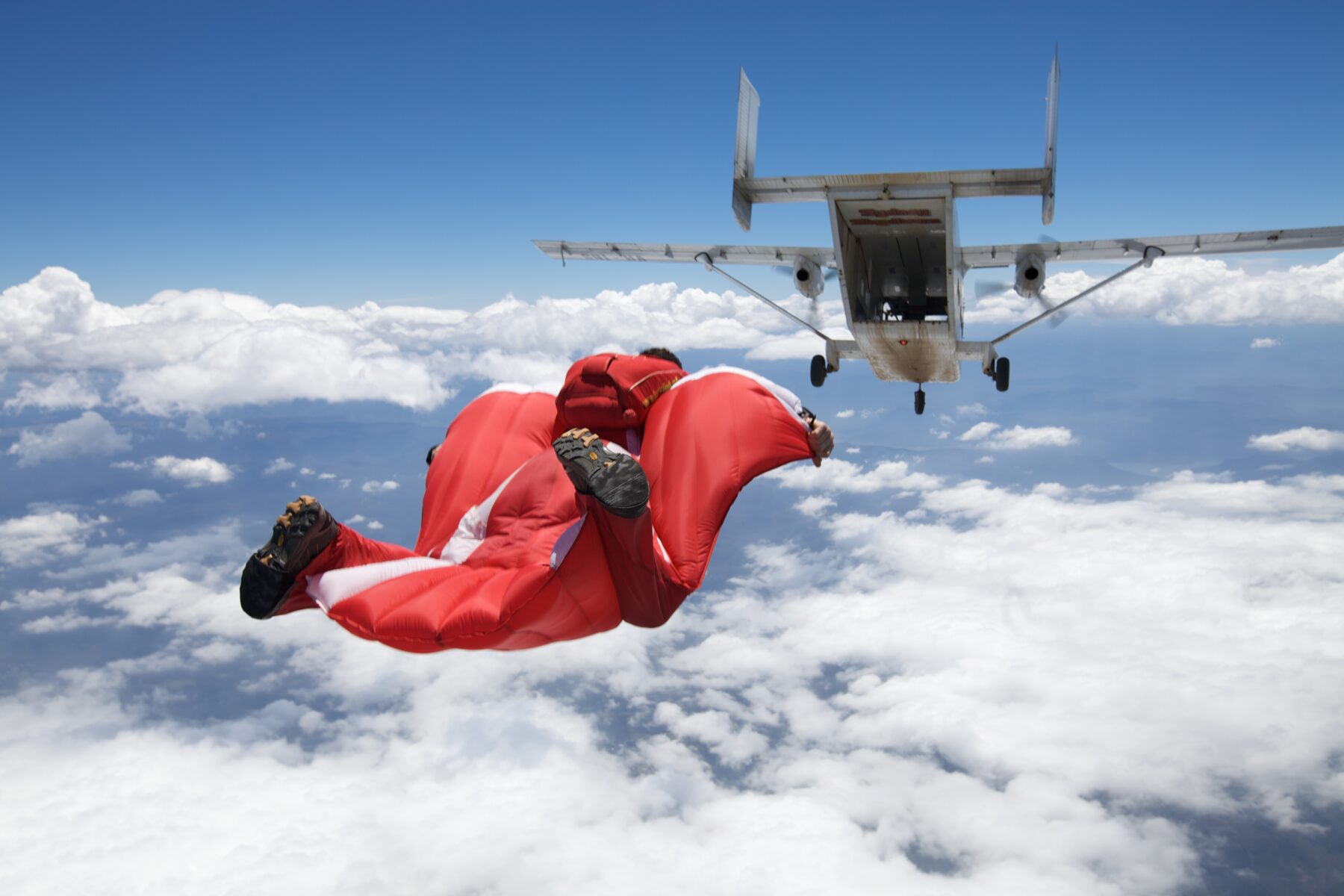
In psychology, ‘peak experience’ is the feeling of euphoria attained when a person becomes totally absorbed in a task or activity, providing them with inexhaustible energy and passion and making them lose their sense of time and space. It’s a profound, mystical state that makes one feel simultaneously powerful and connected to the environment.
Heather says the sport has boosted her emotional intelligence by teaching her how to think more productively and curb unhelpful thoughts that might spiral into anxiety or depression. “Thinking in a way that enhances your health and happiness rather than denigrates it is a very powerful skill, and that can come out of adventures in the wilderness and…progressively growing your comfort zone in a constructive way,” she says.
Extreme sports have an important place in this era of climate change. When discussing CO2 emissions and air pollution, Glenn reflects, “Most people look outside and think air is just the stuff we breathe…whereas for us it’s the stuff we surf, we ride, we glide…we’ve experienced the grandeur of the atmosphere.” The adventures pursued by Glenn and Heather have given them a profound appreciation for nature that has filtered into their everyday life. Today, Glenn shares his passion for adventure with students at the University of Tasmania’s Extreme Sports Medicine program. Heather runs retreats teaching women life skills focused on overcoming limiting fear.
Young Adventurer of the Year
Sponsored by Mountain Designs
Lewi Taylor

Most people aspire to having a few drinks with friends and family on their birthday. On 10 June 2022, the day Lewi Taylor celebrated his 30th birthday, he summited kunanyi / Mt Wellington (1271m). It was the last peak in his quest to conquer the Abels.
Named after Abel Tasman, these 158 mountains have an elevation of 1100m or greater, with a minimum drop of 150m on all sides. The Abels are scattered throughout Tasmania, making it the only Australian state with a ‘peak bagging’ list. At the beginning of the pandemic, Lewi was solo backpacking through Europe and Central America, coming home just before Tasmania closed its borders due to COVID. The young adventurer returned with a strong desire to explore his home state, and he became intrigued by the Abels.
The Abels peak bagging challenge appealed to Lewi’s competitive nature, sports background, and passion for the outdoors. A throwaway comment to a mate – “What if you could climb all 158 Abels, one per day?” – planted the seed of an idea. According to all bushwalking blogs and advice, it wasn’t possible, but Lewi wanted to give it a go.
“I was half-blessed in the sense that I didn’t have a lot of hiking experience,” Lewi says, admitting his first-ever solo, multi-day hike was during the challenge. “I had the naivety and the sporting mindset where anything is possible. If I had more experience or knew more bushwalkers, the thought that this wasn’t possible could’ve begun creeping in.” During the next 18 months, Lewi became absorbed in the project, poring over the literature and meticulously planning his adventure. He began sequencing the Abels into groups, trawling through blogs, forums, archives and books to map out potential hiking routes.
His expedition took on new meaning after his mother was diagnosed with breast cancer for a second time. Now he had a new goal: to raise $158,000 for Cancer Council Tasmania by climbing 158 Abels in 158 days. Six months before embarking on his “158 Challenge”, Lewi launched the fundraiser and rolled out his social media campaigns. At the same time, he was completing his second master’s degree and building a camper trailer for his home base.

Lewi began his “158 Challenge” on 4 January 2022 by climbing three Abels – Collins Bonnet (1261m), Mt Marian (1144m) and Trestle Mountain (1164m) – in less than 9 hours. By the end of the month, he’d bagged 27 peaks. He posted daily updates to his social media, detailing the highs and lows of each day, from the beautiful scenery and people he met along the way, to the challenge’s toll on his joints and muscles. Lewi sometimes invited friends to join him, but he estimates that 85 per cent of his hikes were completed solo. He also had rest days scheduled throughout the challenge, when he returned to Hobart to recharge and buy new food and supplies. Lewi says these were crucial for his longevity, allowing him to recuperate, mentally refresh, and reconnect with family and friends.
Some Abels could be bagged on a day hike, which ranged from two to 10 hours. After summiting the peaks, Lewi returned to his self-built cubby camper to rest. Others were only accessible on a multi-day hikes – sometimes up to 10 days of off-track hiking through Tasmania’s dense wilderness. These proved to be some of the most physically and mentally demanding moments of the challenge. “Walking for up to 15 hours a day, you have a long time to think and reflect on anything that’s going on,” says Lewi. “That either reflects or amplifies; nice, happy thoughts become a very dreamy sort of experience, but negative thoughts or anything unresolved back home and you have 15 hours a day to mull over the negative.”
There were moments when things looked impossible. But Lewi says the Cancer Council fundraiser added a new level of accountability that forced him to keep pushing himself. “The main lesson I got out of the whole experience was…[what] a person is capable of mentally,” he says. “I had never experienced that level of wilderness. Going into it with an open mind and persevering through hard times – it all comes down to resilience.”
Alongside successfully climbing all 158 Abels in 158 days, Lewi’s fundraiser had surpassed his goal, raising nearly $170,000 for Cancer Council Tasmania. The funds will contribute towards cancer prevention education, support services and research. In recognition of his achievement, Lewi was nominated as Tasmania’s Young Australian of the Year in 2023.
Spirit of Adventure
Kate Leeming

Dr Kate Leeming OAM doesn’t do things by halves. To prepare for a cycling assault on Antarctica, she completed a string of expeditions covering every continent, and including journeys to north-east Greenland, Iceland, Mexico’s Baja Divide, the Indian Himalayas, the Andes, Namibia’s entire desert coastline, Antarctica’s Queen Maud Land and Australia’s Finke River.
An ultra-endurance cyclist, Kate continually pushes the boundaries of what’s possible. Since 1990 she’s cycled 96,500km – more than twice the world’s circumference – across 42 countries, with each expedition proving more demanding than the last. She’s arguably best known for her 2010 Breaking the Cycle in Africa expedition, a 22,000km odyssey through 20 countries from west to east, from Senegal’s Pointe des Almadies to Cape Hafun in Somalia.
Kate was introduced to bicycle touring on a trip to Ireland in 1990 and by 1992 had cycled 15,000km across Europe. “I really loved the idea of how connected I was to the people and the land,” she says. “There was a much deeper connection with where I was going, and it produced a very realistic perspective about how the world fits together. That’s the intrinsic reason about why I love to travel this way, and it grew from there.”
In 1993 Kate became the first woman in history to cycle unsupported across what was then known as New Russia, a 13,400km journey from Saint Petersburg to Vladivostok. The five-month expedition raised money for children impacted by the 1986 Chernobyl disaster. In 2004–05, she embarked on her UNESCO-backed Great Australian Cycle Expedition, a circuitous 25,000km route that began and ended outside Canberra’s Parliament House. During her nine-month, unsupported journey through Australia, Kate also became the first woman to cycle the Canning Stock Route, an 1850km track across the Gibson, Great Sandy and Tanami deserts. “These expeditions sharpen me up…and change me in so many ways,” Kate says. “I couldn’t have done one expedition without doing the ones that came before.”

In 2019 she became the first person to cycle Namibia’s 1621km coastline, known as the Skeleton Coast. During the pandemic, Kate’s attention returned to Australia. It was then that she resumed her “Breaking the Cycle Across Australia” expedition, delayed by a broken collarbone and COVID. The adventure involved an 8617km journey across Australia’s interior from Cape Byron, NSW, to Steep Point, WA.
Kate has long had her sights set on that Antarctic expedition. Since 2018, she’s been training for the world’s first bicycle crossing of the continent, via the South Pole. The 3000km supported journey will take an estimated 70 days on her custom-built Christini fat bike. “Antarctica has been ready for a while, but it’s a matter of finding funds,” Kate says.
She was awarded a Medal of the Order of Australia (OAM) in 2023 for services to adventure sport. As well as being a motivational speaker and a real tennis champion, she’s the founder of the Breaking the Cycle Foundation, supporting the grassroots organisations she encountered on her travels and the next generation of young leaders.
Adventurer of the Year
Richard Barnes
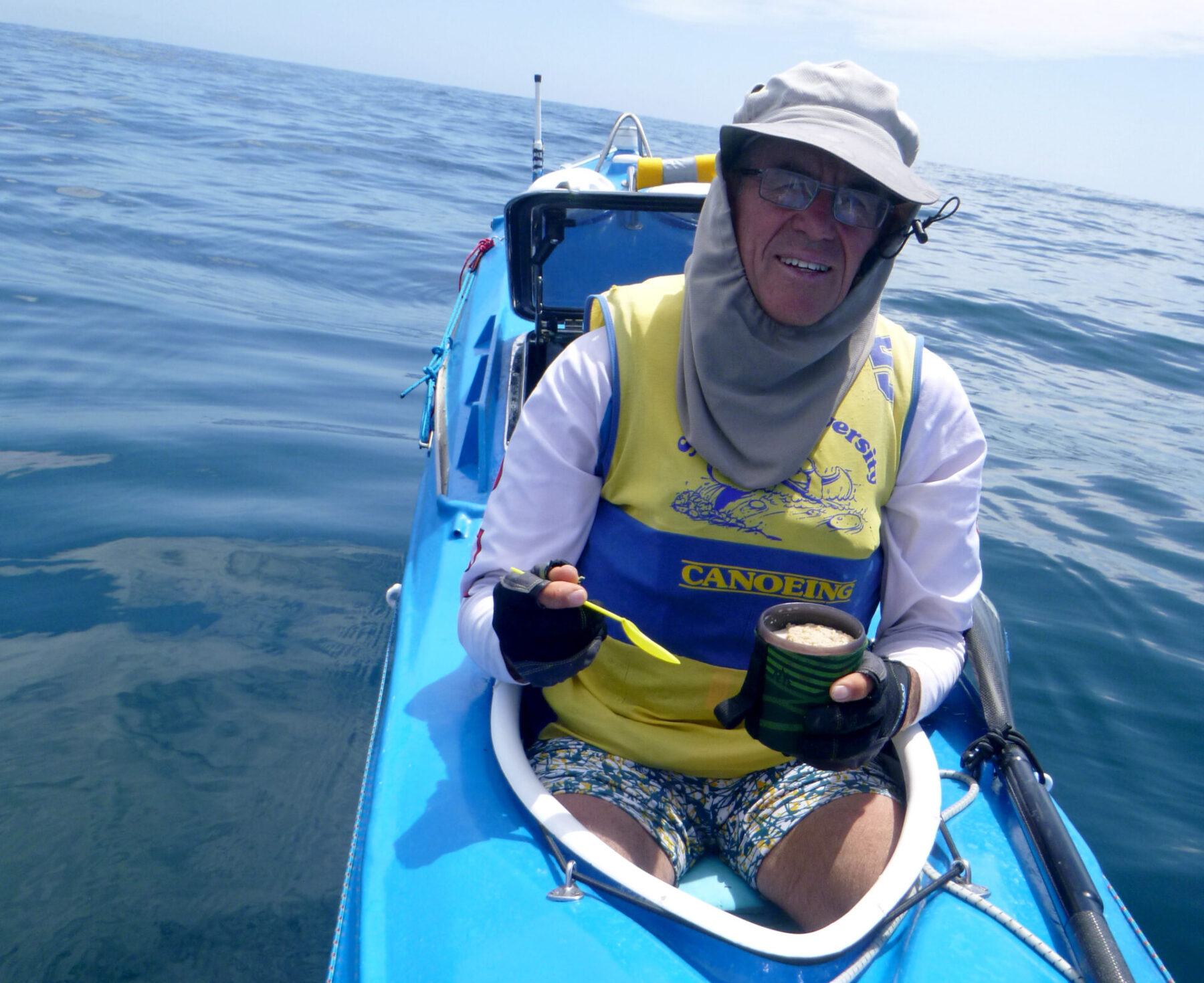
You know a person is determined if it takes nothing less than a cyclone to stop them achieving a goal. On 18 February 2023, Dr Richard Barnes paddled into shore at Riverton, on New Zealand’s South Island, after Cyclone Seth forced him to abort an earlier attempt in 2021. It was the end of a 1676km journey across the Tasman Sea – making Richard the first person in history to kayak solo, non-stop and unassisted from Australia to New Zealand.
Richard’s trans-Tasman adventure was close to 10 years in the making. The seasoned kayaker has racked up an impressive resumé of long-distance expeditions and marathons across six continents. With several crossings of Bass Strait securely under his belt, the Tasman Sea beckoned as the next challenge.
Undeterred by the earlier cyclonic delay, Richard departed from Short Beach in Hobart on 14 December 2022 onboard his self-built kayak, Blue Moon.
The kayak was divided into seven compartments: the cockpit for paddling; two each end for food storage; vestibule for wet clothes, desalinating water and eating; and the citadel for sleeping and protected storage. Blue Moon weighed 700kg at the start of her voyage but shed about 20kg each week. Inside, Richard had stockpiled 100 days of food, such as tinned meat and dehydrated meals, powdered milk, biltong, nuts and his cherished Weetbix, Arnott’s biscuits and Coca Cola.
During the next 67 days, Richard’s sole human contact was through satellite email. He had never experienced such extreme isolation, a challenge both daunting and exciting. The isolation, surprisingly, turned out to be a positive experience overall.
“I certainly learnt that it’s not scary to be alone,” Richard says. “It wasn’t ever; it was just beautiful, peaceful, and wondrous to have the chance to experience and see everything.”
Richard paddled up to 10 hours a day, keeping his mind occupied by memorising laminated poems – Banjo Paterson’s The Man from Snowy River taking him 42 days – and chewing over cryptic crossword clues, trivia questions and word games. He published a blog detailing the daily minutiae of his expedition, from playful interactions with sooty albatrosses and pods of dolphins, to tedious chores such as scraping barnacles off Blue Moon’s hull.
But the journey was not all smooth sailing, and on day 35 came Richard’s greatest test of resilience. In the early hours of the morning, a freak wave capsized his kayak, which then self-righted. Richard discovered Blue Moon’s sea anchor had disappeared, and the rudder steering system was broken.
“Those three things combined were tough,” Richard admits. But his adventuring experience and engineering background gave him a positive outlook. “Think about what went wrong, find answers, solve the problem and press on,” he says.
Now, having claimed a new world record, Richard encourages people to pursue their goals, no matter how big or ambitious. “People should take on their own adventures, at whatever level,” he says. “The rewards are just so great.”
Lifetime of Conservation
Brigitte Stevens

In 2006 an orphaned wombat joey called Barney came into Brigitte Stevens’s care, and changed both their lives.
Brigitte, founding director of the Wombat Awareness Organisation, decided to dedicate her life to southern hairy-nosed wombats. Since 2006 she’s rescued and rehabilitated more than 10,000 wombats and successfully advocated for stronger legislative protections for the marsupials. Her sanctuary for injured, orphaned and misplaced wombats is the largest of its kind in the world.
Brigitte began her career in 1998 at Queensland Reptile and Fauna Park (now Australia Zoo), working under Steve Irwin and specialising in native mammals. During the next several years, she worked in various supervisory and curatorial roles in wildlife parks and zoos across Queensland. “I had always worked with wombats but hadn’t yet experienced having a bond with them,” she admits. “I didn’t realise what incredible animals they are.”
Barney had several health problems. Moving to South Australia offered his best chance of survival, so Brigitte sold everything and moved interstate to begin a new life on wombat country. She soon discovered that southern hairy-nosed wombats across SA were suffering from habitat loss, malnutrition, mange, human-inflicted cruelty and more. Landholders and local councils were culling wombats without following the humane code of practice – including destroying burrows and intentionally burying wombats alive. In 2007 she began collecting footage of this and making reports to the RSPCA and state government. Three years later, she created the Wombat Mitigation Program, enlisting 72 farming properties that routinely culled wombats and offering free advice about non-lethal alternatives, but to little avail. In 2012 she met with Tammy Franks, Greens MLC of SA, and they began lobbying for wombat burrows to be protected by law. Their breakthrough came a decade later, when a farmer admitted on camera to burying wombats alive on his property. Tammy instigated a new Bill in Parliament – declaring it illegal to bury wombats alive in their burrows in SA – that passed in both the Upper and Lower Houses and became law in June 2023.

Brigitte lives on-site at her sanctuary, alongside wildlife biologist Clare Jans. The 20ha property is a refuge for roughly 100 wombats that can’t return to the wild, whether from injury, sickness or habitat loss. For Brigitte and Clare, it’s round-the-clock wombat care. As well as being involved in food preparation, administering medicine and property maintenance, they bottle-feed orphans, monitor sick wombats, and respond to calls from their 24/7 statewide wombat rescue service. It’s exhausting, but Brigitte says it brings her “immense joy”. “I was a lost person before I came across wombats,” she says.
Her animals are treated by a dedicated team of veterinarians and specialists, including cardiothoracic surgeons and pulmonologists. “The knowledge we have gained of wombat illnesses is incredible,” Brigitte says. “We are getting diagnostics not often seen in wildlife in Australia and developing effective treatment plans for these illnesses.” She has also organised sarcoptic mange treatment programs and support-feeds wild populations afflicted with liver and kidney damage after digesting toxic weeds.
Brigitte now has her sights set on the future.
“I’ve really got my focus set on creating a sanctuary that will way outlast me,” she says. She feels she is outgrowing her sanctuary, and wants to relocate to a larger site.
Conservationist of the Year
Karrina Nolan

Original power, headed by executive director Karrina Nolan, has been working to address the lack of clean, affordable power available to Aboriginal and Torres Strait Islander households. Existing infrastructure regularly leaves many First Nations communities disconnected from energy sources – sometimes for days at a time – with detrimental impacts on people’s health and wellbeing.
As well as fronting Original Power, Karrina is a member of the First Nations Clean Energy Network steering committee.Both organisations are building the capacity of communities to self-determine what happens on Country by providing them with networks, training, and resources. Karrina is a Yorta Yorta woman who has spent her career organising and managing programs in First Nations communities across Australia. In the past decade, her focus has shifted towards climate change, ensuring that Aboriginal and Torres Strait Islander communities have greater energy security, participate in the renewable energy revolution, and equitably benefit from clean energy projects.
Many First Nations communities are situated on the frontlines of fossil fuel projects. Instead of being reactive to developments or proposals, Karrina says Traditional Owners must be included in project planning. “We’ve got a long history of extractive mining being done to our people and communities,” she says. “Both organisations are really committed to making sure our communities can protect Country, sacred sites, water and land.”
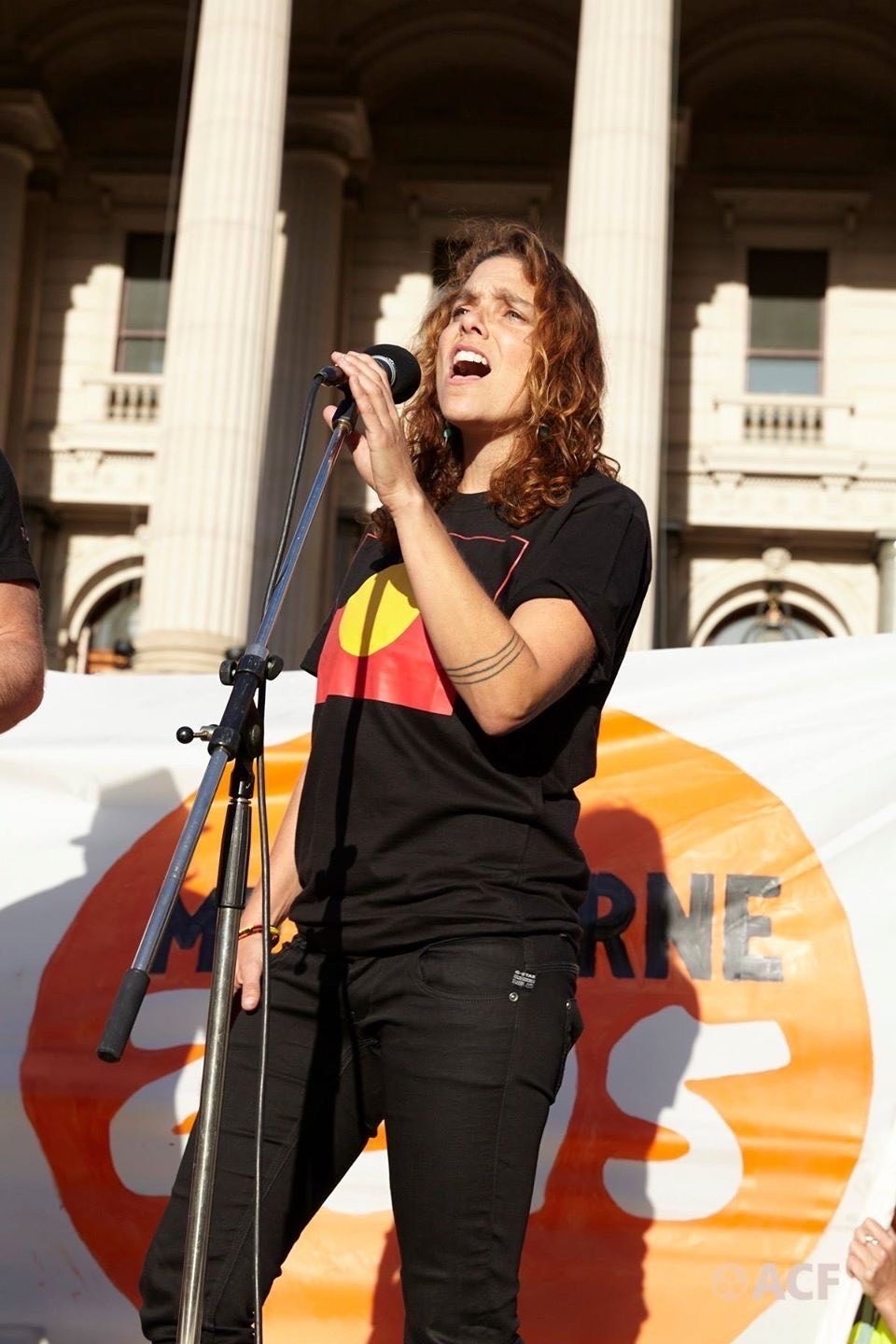
Original Power and the First Nations Clean Energy Network build a community’s ability to challenge or consent to fossil fuel projects, negotiate equitable arrangements for large-scale renewable projects on their lands, or alternatively pursue community-owned clean energy projects. Karrina and her team are working with the federal government to develop the First Nations Clean Energy Strategy. It’s modelled on a Canadian concept, which Karrina says has developed hundreds of First Nations-led clean energy projects and generated $1.5 billion in Indigenous procurement.
“They’re about a decade ahead of us,” Karrina says. “One of the things the Canadians have done well is get government and industry to work together, incentivising businesses that are doing best practice and making sure there are genuine benefits of engagements and consent.”
By working hand-in-hand with both government and industry, the network aims to develop renewable energy projects on Country. But there’s more work to be done, both on policy reform and forging partnerships between communities and industry.
Original Power has conducted demonstration projects around Australia – from installing solar panels on rental properties to developing solar microgrids – to ensure that First Nations communities actively participate in the clean energy revolution and benefit from it. As well as slashing energy costs and reducing a community’s reliance on diesel, these demonstration projects have improved energy security.
There’s a long way to go, but Karrina has a positive outlook for the future. “None of this is an individual effort,” she says. “It’s a collective project that will take all of us.”

